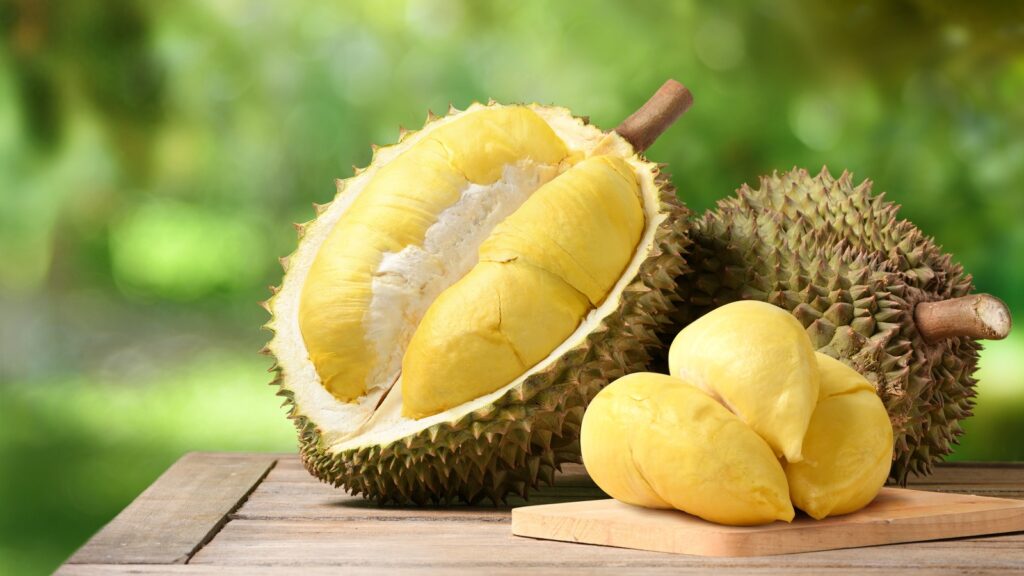PREFER TO WAtch this article as a video ?
Guava (fa-rang) – This fruit, available year-round, derives its name from its origins in tropical America, meaning “white” or “Westerner”. It’s a popular choice in Thailand, often accompanied by a salt-sugar-chilli dip. Note: Avoid the core, filled with tiny seeds that can cause constipation.

Tamarind (ma-kham) – The versatile tamarind, known for its tart and tangy flavor, can be enjoyed fresh or candied and is even used in Thai cuisine. Caution: Watch out for the hard seeds and remember, tamarind is a natural laxate.

Papaya (ma-la-kor) – Highly popular in Thailand, papaya is often served with a squeeze of lime juice. While there are several varieties, a common sight is the two kinds found in supermarkets. Tip: Remove seeds and enjoy the flesh with a spoon.

Longan (lam-yai) – Flourishing from May to June in the north of Thailand, longan boasts a sweet, distinctive taste. It can be enjoyed fresh, candied, or brewed into tea. Note: Longan is considered a “warming” fruit, ideal for those seeking to raise their energy levels.

Rambutan (ngo) – With its unique appearance, featuring a red, hairy covering, rambutan is hard to miss. Its sweet flesh is found across various varieties. Reminder: The flesh does not easily come off the wood-like seed.

Litchi (lin-chee) – Originating from China and widely grown in northern Thailand, litchi offers a sweet and slightly tart taste. Its hard pit varies in size based on the variety. Caution: Like longan, litchi is also considered a “warming” fruit, best enjoyed in moderation.

Coconut (ma-phrao) – The refreshing coconut water is excellent for hydration, containing natural electrolytes. Enjoy the water directly from the coconut with a straw, and don’t forget to savor the tender flesh of a young fruit.

Kiwano/Gac Fruit (fakh-khao) – Gac, a superfruit, has a subtle and slightly sweet taste, though eating it can be messy. Often turned into a sweetened drink, you can find it at local markets during the year’s end. Note: Gac is not easily accessible and typically found in peak season markets.

Salak/Snake Fruit (sa-lak) – Salak fruit’s spiky skin resembles a cactus and can be challenging to remove. However, its tangy and sweet taste is well worth it. Reminder: Some street-side vendors offer already-peeled fruit.

Passion Fruit (sao-wa-rot) – Another superfruit, passion fruit’s sweet and tart pulp can be enjoyed directly from the fruit or as juice. Its edible seeds provide a delightful crunch and a good source of fiber.

Carambola/Star Fruit (ma-fueng) – In season from October to December, the star-shaped carambola is sweet and juicy with a hint of sourness. It’s perfect for quenching thirst and pairs well with various dips. Note: Soak and scrub the fruit before consumption to remove wax.

Durian (thu-rian) – Despite its strong aroma, durian is a must-try, with variations like mon-thong being less pungent. Opinions on its creamy flesh are divided, but its uniqueness is undeniable.

Dragon Fruit (kaew-mang-korn) – This unusual-looking superfruit originates from Vietnam but has gained popularity in Thailand. Available in white and purple flesh varieties, it’s packed with nutrients and has a subtle taste. Tip: Peel off the thick skin or scoop out the flesh with a spoon.

Mangosteen (mang-khut) – A favorite among Thai fruits, mangosteen peaks from May to July. Its sweet and tangy white pulp is divided into segments, some containing seeds. Note: Cut the rind laterally and enjoy the fruit directly from the peel.

Mango (ma-muang) – Thai mangoes come in various varieties, both ripe and unripe. Enjoy them plain, with coconut cream, or paired with savory dips. Stay tuned for the introduction of a new purple mango variety.

Annona/Custard Apple (noi-na) – Originally from Central America, the delicate custard apple offers sweet and creamy white flesh. Don’t forget to seek out noi-na ice cream for a creamy treat.

Rose Apple (chom-phu) – Shaped like a pear, the rose apple is crisp and slightly sweet. Remove the seeds, and its red and green varieties are a hit with children.

Watermelon (taeng-mo) – Available year-round, watermelon comes in watery red pulp or yellow pulp varieties, perfect for quenching thirst or turning into a refreshing slushie.









